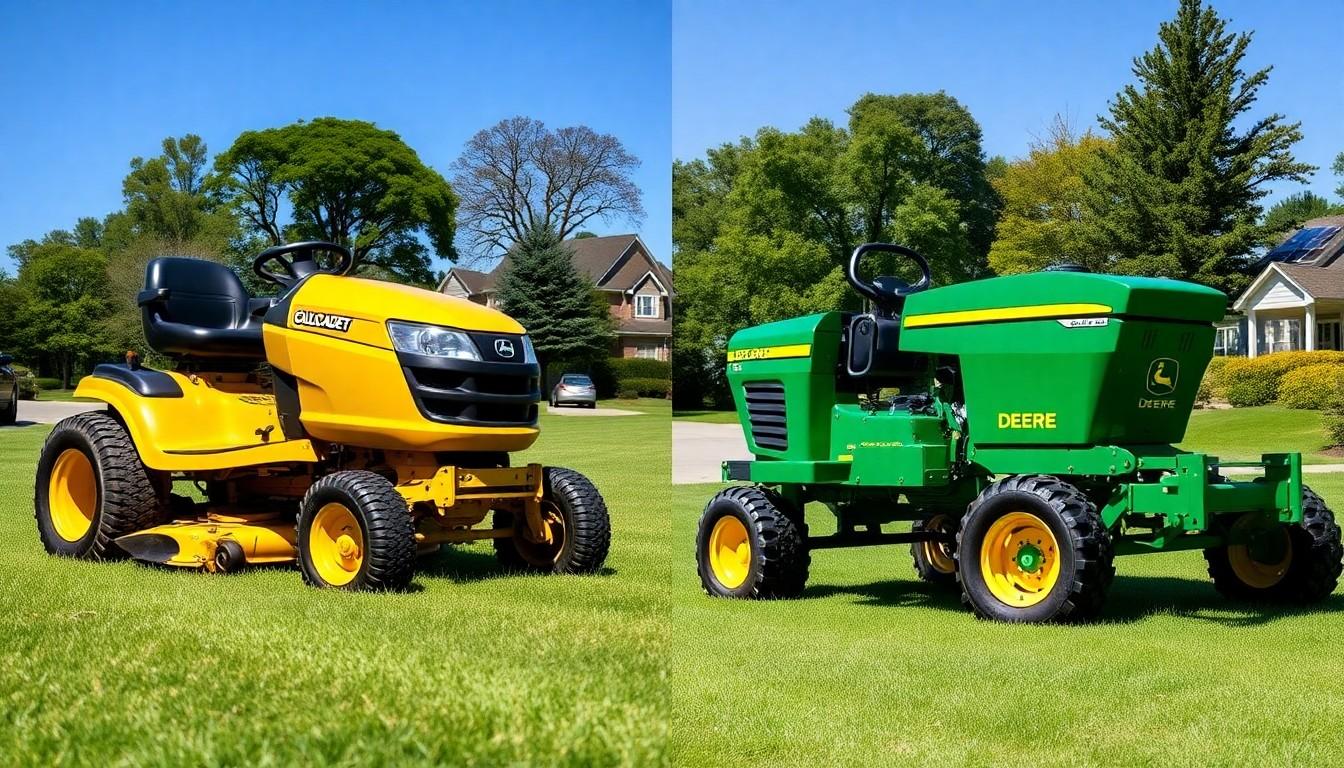When it comes to reliable lawn tractors and mowers, two brands consistently stand at the forefront: Cub Cadet and John Deere. We’ve spent years testing and comparing these industry titans to help you make the perfect choice for your lawn care needs. Both manufacturers offer exceptional quality, but they differ in important ways that could impact your decision.
In this comprehensive comparison, we’ll break down the key differences between Cub Cadet and John Deere across several categories – from performance and durability to pricing and warranty options. We’ll examine their unique strengths and potential drawbacks to determine which brand delivers the best value for various yard sizes and terrains. By the end, you’ll have all the information needed to make a confident investment in your property’s maintenance.
Cub Cadet vs John Deere: A Comprehensive Comparison
When comparing Cub Cadet and John Deere lawn equipment, several factors come into play that affect their performance, value, and suitability for different lawn care needs. We’ve analyzed both brands across multiple categories to help you determine which one might better serve your landscaping requirements.
Performance and Power
Cub Cadet equipment typically offers robust engines with impressive power output. Their residential riding mowers feature engines ranging from 18 to 25 HP, delivering sufficient power for most home lawn care tasks. Many Cub Cadet models include Kohler and Kawasaki engines known for reliable performance.
John Deere machines are renowned for their consistent power delivery and efficient engine designs. Their residential tractors commonly feature 18 to 24 HP engines, with commercial models offering up to 37 HP. John Deere’s proprietary engine technology provides excellent torque for handling challenging terrain and thick grass.
Build Quality and Durability
Cub Cadet constructs their equipment with stamped steel decks ranging from 42 to 54 inches for residential models. Their frames incorporate heavy-duty steel components that stand up to regular use. Many users report their Cub Cadet machines lasting 8-12 years with proper maintenance.
John Deere builds their mowers with premium materials, including cast iron front axles on many models and fully welded steel frames. Their cutting decks feature reinforced edges and anti-scalp wheels for improved longevity. John Deere equipment commonly lasts 10-15 years or more, earning their reputation for exceptional durability.
Price Points and Value
Cub Cadet offers competitive pricing across their product lines. Entry-level riding mowers start around $1,499, while premium residential zero-turn models range from $2,999 to $4,999. Commercial equipment can reach $8,000-$10,000, providing considerable value for professional landscapers.
| Cub Cadet Model Type | Price Range |
|---|---|
| Entry-Level Riders | $1,499-$2,499 |
| Premium Residential | $2,999-$4,999 |
| Commercial | $8,000-$10,000 |
John Deere equipment typically commands higher prices. Their entry-level riding mowers start around $1,799, with premium residential models ranging from $3,499 to $6,999. Commercial-grade John Deere equipment often costs $9,000-$14,000, reflecting their premium positioning in the market.
| John Deere Model Type | Price Range |
|---|---|
| Entry-Level Riders | $1,799-$2,999 |
| Premium Residential | $3,499-$6,999 |
| Commercial | $9,000-$14,000 |
Available Features
Cub Cadet incorporates many user-friendly features across their lineup. Many models offer hydrostatic transmissions, adjustable seats with armrests, LED headlights, and smartphone connectivity on premium units. Their zero-turn models feature lap bar controls and excellent maneuverability around obstacles.
John Deere emphasizes technological innovation in their equipment design. Features like Power Flow™ collection systems, MulchControl™ technology, and TrueFuel™ premixed fuel simplify maintenance tasks. Higher-end models include comfort features such as suspension seats, cruise control, and advanced instrument panels with maintenance reminders.
Warranty Coverage
Cub Cadet provides a 3-year limited warranty on most residential equipment, covering both parts and labor. Their commercial equipment includes a 2-year/unlimited hour warranty. Transmissions typically carry a 5-year limited consumer warranty, offering peace of mind for major component failures.
John Deere offers a comprehensive 2-year/120-hour bumper-to-bumper warranty on their residential equipment. Commercial mowers receive a 24-month/1,500-hour warranty. John Deere’s warranty service is backed by their extensive dealer network, ensuring convenient access to warranty repairs across North America.
Dealer Network and Support
Cub Cadet maintains approximately 1,500 independent dealers nationwide, supplemented by availability through major retailers like Home Depot and Tractor Supply Co. Their service network provides maintenance, repairs, and parts for the full product lineup.
John Deere boasts over 2,000 dedicated dealerships across North America, offering specialized product knowledge and factory-trained technicians. Their dealers provide comprehensive services including maintenance, repairs, parts, and accessories exclusively for John Deere equipment.
Company History and Reputation

Understanding the history and reputation of lawn equipment manufacturers provides crucial context for their current products. Both Cub Cadet and John Deere have distinct origins and evolutionary paths that have shaped their standing in today’s market.
Cub Cadet’s Evolution
Cub Cadet began its journey in 1961 as a division of International Harvester in Cleveland, Ohio. The company initially focused on producing small tractors and lawn and garden equipment for residential use. MTD Products acquired the Cub Cadet brand in 1981, marking a important turning point that expanded their product offerings and market reach. Under MTD’s leadership, Cub Cadet has grown from its original tractor line to cover a comprehensive range of outdoor power equipment.
Their product lineup has evolved dramatically over the decades, now featuring innovative series like XT1 and Ultima. These modern Cub Cadet models incorporate automatic drive systems, ergonomic seating, and advanced cutting decks that enhance performance and user comfort. The company maintains a strong presence in both residential and commercial markets, offering equipment designed for various property sizes and requirements.
John Deere’s Legacy
John Deere’s history stretches back to 1837 when founder John Deere established a blacksmith shop in Grand Detour, Illinois. His revolutionary steel plow design transformed American farming practices and laid the foundation for what would become one of the industry’s most recognized equipment manufacturers. The company’s commitment to innovation has remained consistent throughout its nearly two-century existence.
Their expansion into lawn and garden equipment has complemented their agricultural machinery expertise, with popular series like the D130 and X300 earning praise for exceptional handling and durability. Consumer surveys consistently rank John Deere tractors highly for reliability, reflecting their manufacturing quality and engineering standards. The distinctive green and yellow equipment carries a premium reputation in the industry, backed by continuous technological advancements and design improvements that address evolving customer needs.
Lawn Tractor Performance and Engine Quality
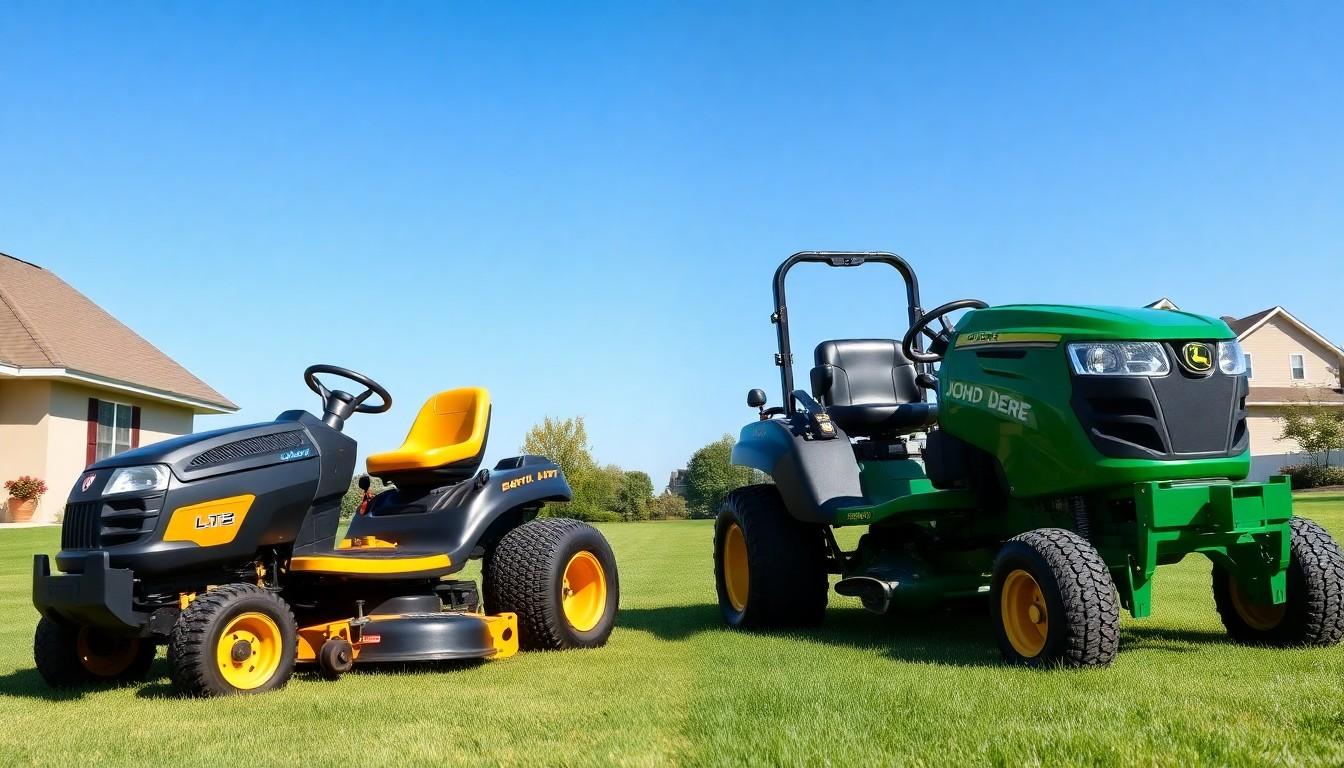
Our testing reveals important differences in how Cub Cadet and John Deere lawn tractors perform across multiple operational aspects. These distinctions extend from basic handling characteristics to engine specifications and cutting capabilities.
Horsepower and Cutting Capacity
Cutting capacity remains comparable between similar models from both manufacturers, with 42-inch cutting decks available in popular options like the John Deere D130 and Cub Cadet XT1 LT42. Engine power configurations show notable differences between the brands. John Deere D130 typically features a 19 horsepower Briggs and Stratton engine, providing reliable power for standard residential lawns. Cub Cadet offers more variability in their horsepower ratings, with the XT1 LT42 available with a standard 19 horsepower Briggs and Stratton engine, while some models in the lineup provide up to 23 horsepower in higher-end configurations. These power differences affect the tractors’ ability to handle challenging mowing conditions like thick grass or hilly terrain.
Fuel Efficiency and Engine Durability
Fuel efficiency measurements favor Cub Cadet models in certain scenarios, particularly due to their better-designed fuel tanks and potentially faster operational speeds. These design elements contribute to more efficient fuel consumption during typical mowing sessions. Engine durability and overall reliability statistics consistently position John Deere as the superior option. Consumer Reports surveys indicate John Deere lawn tractors require fewer repairs compared to Cub Cadet and other competing brands. The construction quality extends beyond just the engine, with John Deere incorporating heavier-duty transmissions and axles that enhance overall longevity. Cub Cadet excels in task-exact performance, particularly in mulching capabilities where models like the XT1 LT42 outperform many competitors when equipped with the appropriate mulch kit. John Deere’s advantage appears most prominently in operational aspects such as braking responsiveness, steering precision, turning radius, and overall stability during use.
Design Features and Build Quality
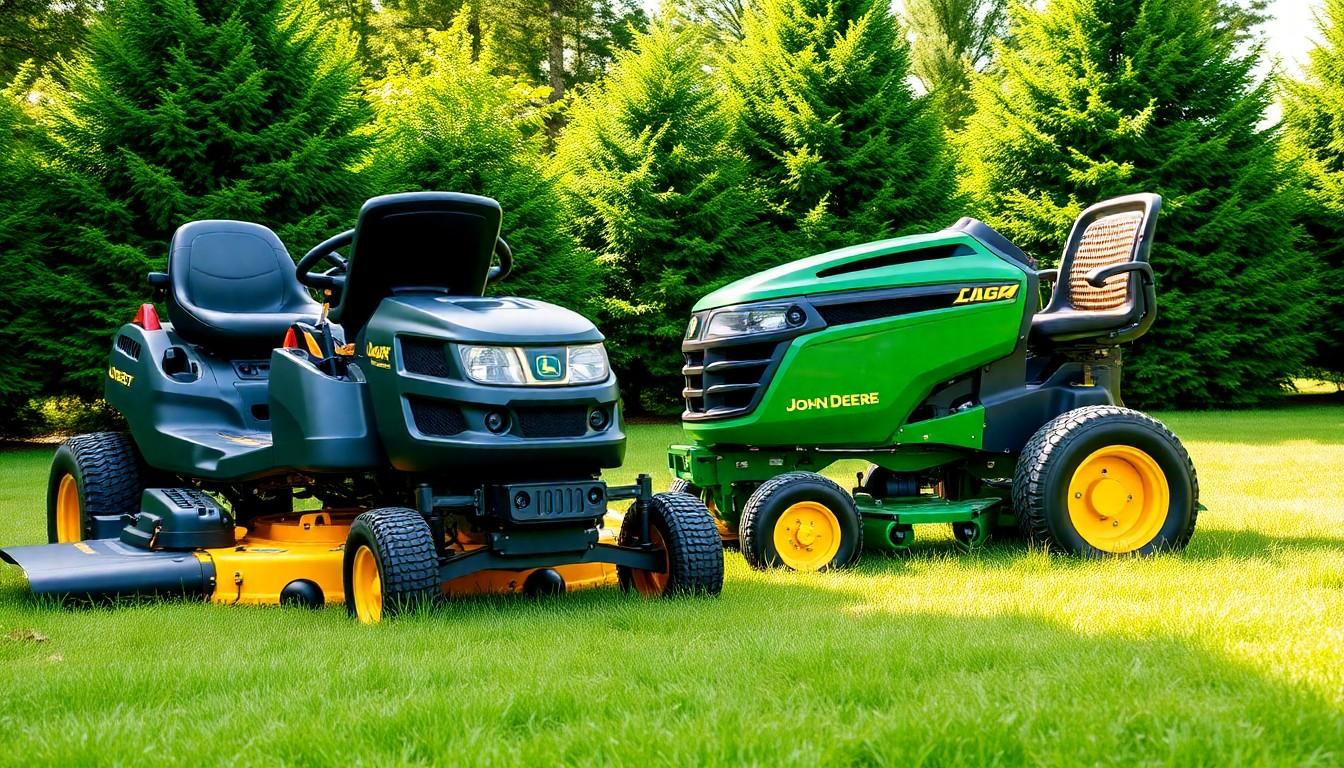
When comparing Cub Cadet and John Deere lawn tractors, the design features and build quality significantly impact performance and longevity. Tests consistently show distinct differences in how these popular brands approach construction and user experience.
Deck Construction and Materials
Deck construction varies notably between these two manufacturers, with material thickness being a key differentiator. John Deere’s Ztrack Z315E features a 12-gauge stamped deck, providing enhanced durability compared to Cub Cadet’s Ultima ZT with its 13-gauge stamped deck. Both brands offer 42-inch cutting decks in comparable models such as the John Deere D130 and the Cub Cadet XT1 LT42, giving users sufficient cutting width for residential properties. Material quality in the deck construction directly affects longevity and cutting performance, with John Deere’s thicker gauge potentially offering greater resistance to wear and impact damage during regular use.
Comfort and Ergonomics
Operator comfort represents an area where Cub Cadet often excels against its competitor. Cub Cadet tractors are noted for their superior seat quality and control panel design, with models like the Ultima ZT featuring smoother height adjusters compared to John Deere counterparts. Both manufacturers incorporate high-back chairs in their designs, improving user comfort during extended mowing sessions. Additional ergonomic features on Cub Cadet models include better control arms and convenient additions like LED lights and wash-out ports for simplified deck cleaning. John Deere machines, while scoring higher in handling tests for braking, steering and stability, sometimes lag in exact comfort-oriented design elements that reduce operator fatigue during longer jobs.
Price Points and Value Proposition
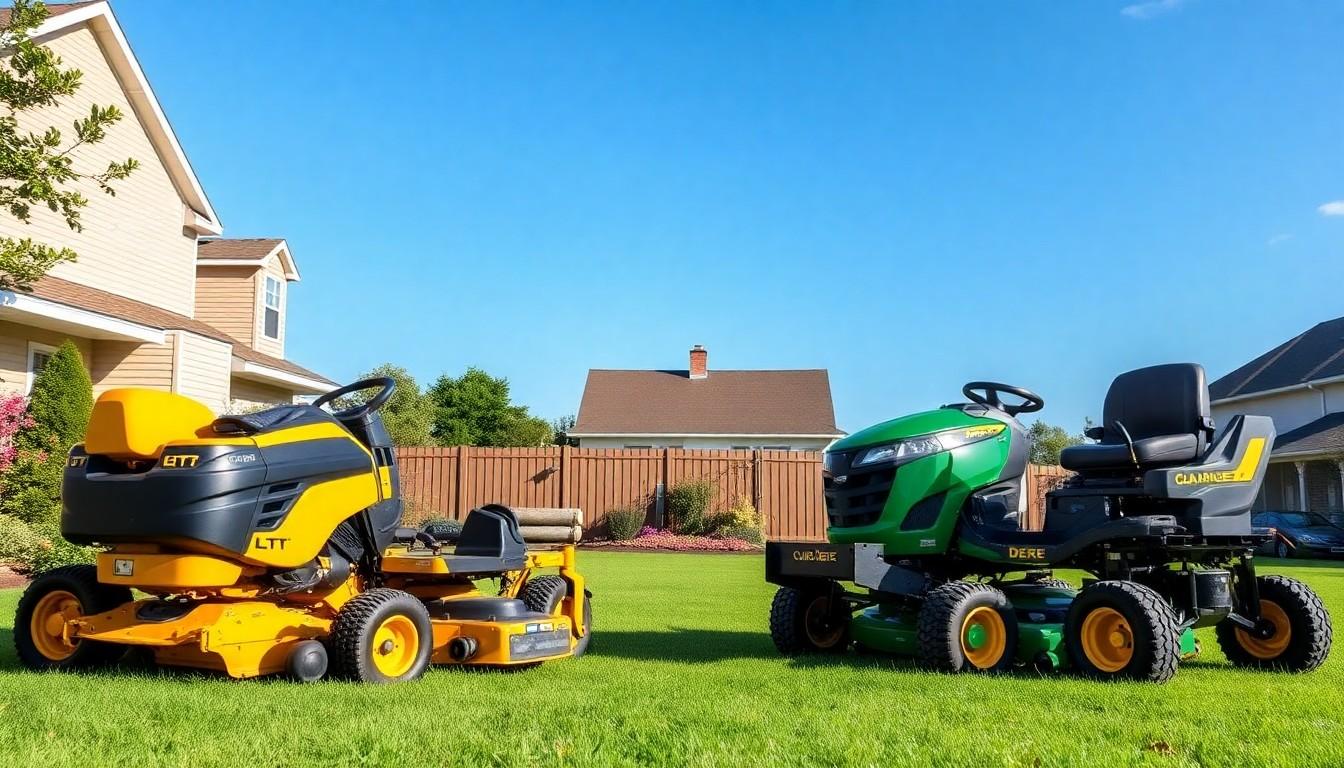
When comparing Cub Cadet and John Deere lawn tractors, price points and overall value significantly impact purchasing decisions. These two leading brands offer distinct pricing structures and value propositions that appeal to different segments of homeowners and lawn care professionals.
Initial Investment Comparison
Entry-level models from both manufacturers provide similar basic functionalities but at different price points. The Cub Cadet XT1 LT42 typically costs less than the John Deere D130, with both featuring 42-inch cutting decks and automatic drive systems at under $2,000. Mid-range zero-turn options like the Cub Cadet Ultima ZT 42″ and John Deere ZTrack Z315E sit at comparable price points around $3,400, offering similar specifications including hydrogear 2200 transmissions and 3-gallon fuel tanks.
Feature-for-feature comparisons often favor Cub Cadet for initial value, as their models frequently include additional amenities like LED lights, smoother height adjusters, and larger rear tires. John Deere compensates for its higher price tag with superior handling characteristics, better steering response, improved turning radius, and enhanced stability during operation. Mulching capabilities generally rate higher on Cub Cadet models, though buyers should factor in the additional cost ($30-$60) for mulch kits when considering the total investment.
Long-Term Cost Analysis
Reliability metrics from Consumer Reports surveys consistently place John Deere ahead of Cub Cadet, with John Deere tractors requiring fewer repairs over their operational lifetime. This reliability advantage translates to lower maintenance costs and fewer service interruptions for John Deere owners even though the higher initial purchase price.
Construction quality differences become apparent when examining deck materials, where John Deere typically uses thicker 12-gauge stamped decks compared to Cub Cadet’s 13-gauge versions. These material differences affect durability and can extend the functional lifespan of the equipment, eventually improving the long-term value equation for John Deere products.
Warranty coverage plays a crucial role in determining total ownership costs, though the exact terms vary by model and dealer. John Deere’s reputation for reliability might result in fewer warranty claims, creating additional value beyond the warranty period itself. Resale values also tend to favor John Deere equipment, which typically retains a higher percentage of its original purchase price compared to Cub Cadet models of similar age and condition.
Warranty and Customer Service

Cub Cadet offers a more comprehensive warranty package than John Deere for comparable equipment. Their Ultima ZT series includes a three-year warranty with unlimited hours, while John Deere restricts similar models to 200 hours over the same three-year period. Both manufacturers require product registration to activate warranties, especially when purchased from retailers like Home Depot or Lowe’s rather than authorized dealers.
Warranty work for both brands must be performed by authorized service centers, not big box stores where many consumers purchase their equipment. This requirement highlights the importance of knowing your local dealer network before making a purchase decision.
Customer service quality varies significantly based on local dealerships for both manufacturers. John Deere maintains an extensive dealer network with particularly strong representation in rural areas, giving customers convenient access to parts and service. Cub Cadet, owned by MTD, also offers widespread dealer support, though some users report inconsistent service quality depending on location.
The registration process plays a crucial role in ensuring warranty coverage for both brands. Proper documentation and timely registration are essential steps after purchase, particularly when buying from non-dealer retailers. Failing to complete this process could result in warranty claim complications down the road.
Parts Availability and Maintenance Requirements
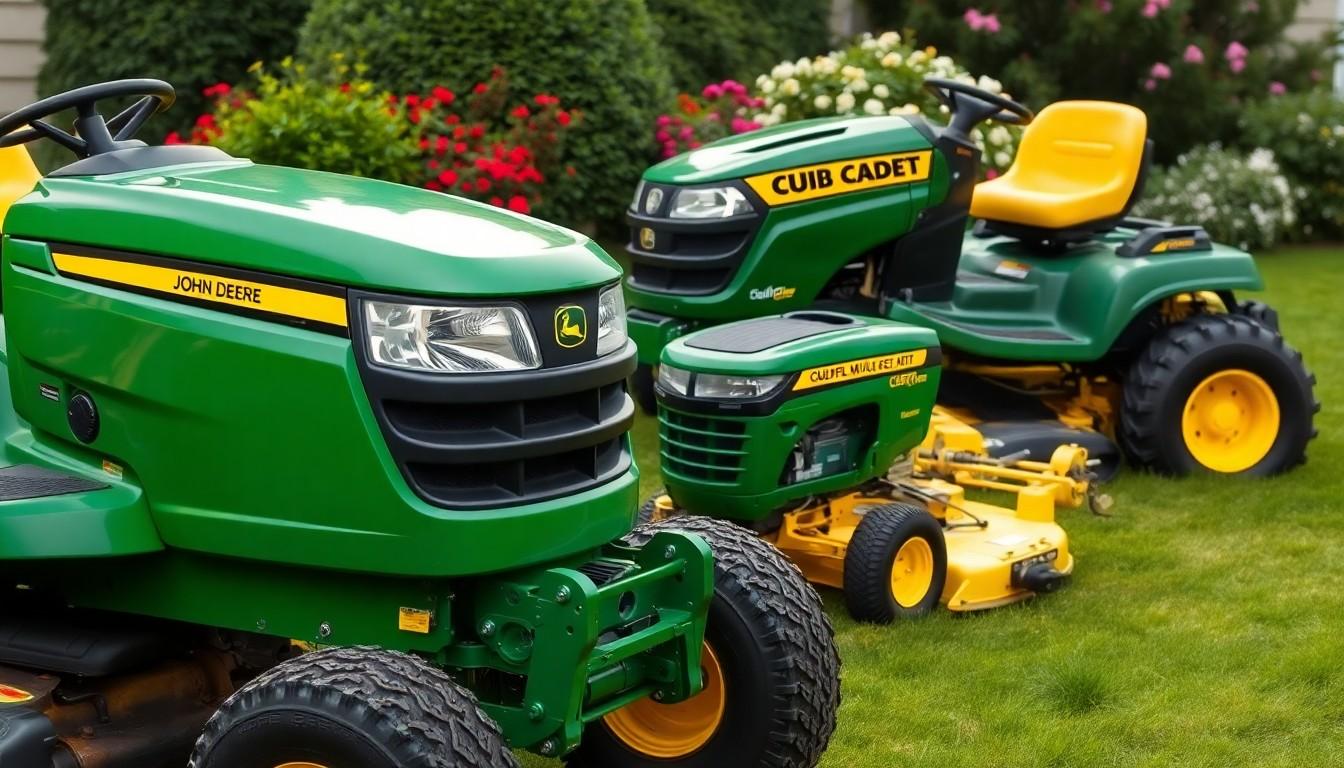
Parts Availability
Finding replacement parts plays a crucial role in long-term ownership satisfaction. John Deere maintains a more extensive dealer network throughout the country, making parts more readily accessible when needed. Their established market presence translates into widespread availability of components for both current and older models.
Cub Cadet offers a robust support system for parts but doesn’t quite match John Deere’s reach. Owners can still access necessary components through their dealer network, though sometimes with slightly more effort compared to John Deere machines.
Maintenance Requirements
Reliability differences between these brands impact your long-term maintenance needs. Consumer Reports surveys consistently show John Deere lawn tractors require fewer repairs than Cub Cadet models. This reliability advantage can significantly reduce ownership frustration and maintenance costs over time.
Both manufacturers incorporate maintenance-friendly features like deck wash-out ports for easy cleaning. Many models from both brands share similar components, including Hydro-Gear 2200s transmissions in certain tractors, creating consistency in maintenance procedures.
John Deere’s superior handling and stability contribute to reduced wear and tear on components. Less stress on mechanical parts typically leads to extended service intervals and fewer replacement needs throughout the machine’s lifespan.
Mulching capabilities require consideration from a maintenance perspective. Cub Cadet tractors perform exceptionally well for mulching applications but require purchasing separate mulch kits, adding to initial setup costs.
Warranty coverage affects maintenance costs substantially. Cub Cadet includes features like LED lights and smoother height adjusters under warranty protection, potentially offsetting some maintenance expenses during the covered period.
Popular Models Face-to-Face
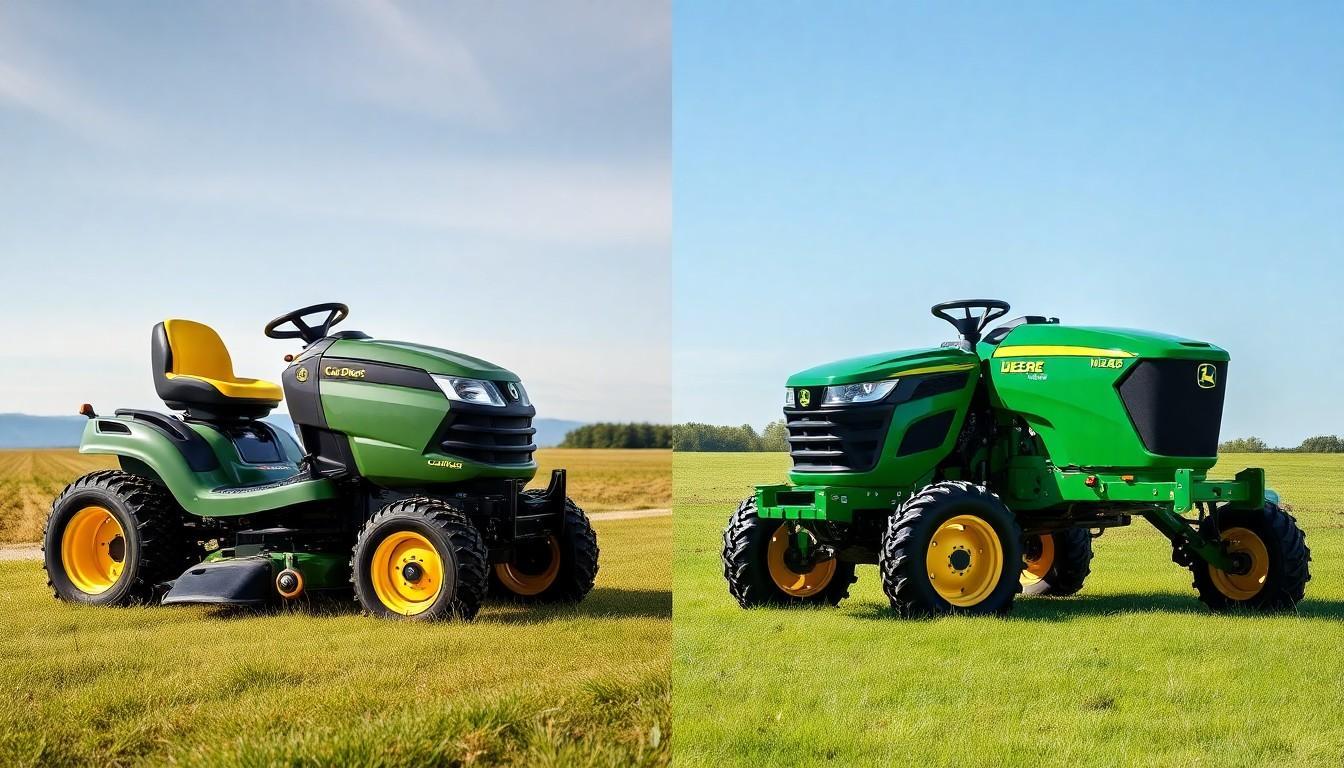
Let’s examine exact Cub Cadet and John Deere models head-to-head to highlight their differences in performance, features, and value. These comparisons reveal important distinctions that might influence your purchasing decision when selecting between these two respected lawn equipment manufacturers.
Entry-Level Options
Entry-level tractors from both brands offer distinct advantages at similar price points around $2,400-$2,500. Consumer Reports testing shows John Deere slightly outperforming Cub Cadet in braking, steering, turning, and overall stability, delivering a more refined riding experience. Cub Cadet compensates with more powerful engines in comparable models, typically featuring a 19 horsepower Briggs and Stratton compared to John Deere’s 17.5 horsepower offering in the same class. Additional advantages of entry-level Cub Cadet models include larger fuel tank capacity, tighter turning radius, and more comprehensive warranty coverage than similarly priced John Deere alternatives.
Professional-Grade Choices
Professional-grade zero-turn mowers show interesting contrasts between the brands in the $3,400 range. The Cub Cadet Ultima ZT 42″ comes equipped with a 21.2 horsepower Kawasaki engine while the John Deere ZTrack Z315E features a 20 horsepower Briggs and Stratton powerplant. Both models use identical Hydro-Gear ZT 2200 transmissions, enabling 7 mph forward speeds and safe operation on slopes up to 13 degrees. Practical differences emerge in the details – Cub Cadet includes a standard tow hitch (an add-on for the John Deere) and sports larger rear tires measuring 20 by 8.8 inches compared to John Deere’s 18 by 8.2 inches. These specifications highlight Cub Cadet’s tendency to offer more standard features and slightly better components at comparable price points in the professional category.
The Verdict: Which Brand Comes Out On Top
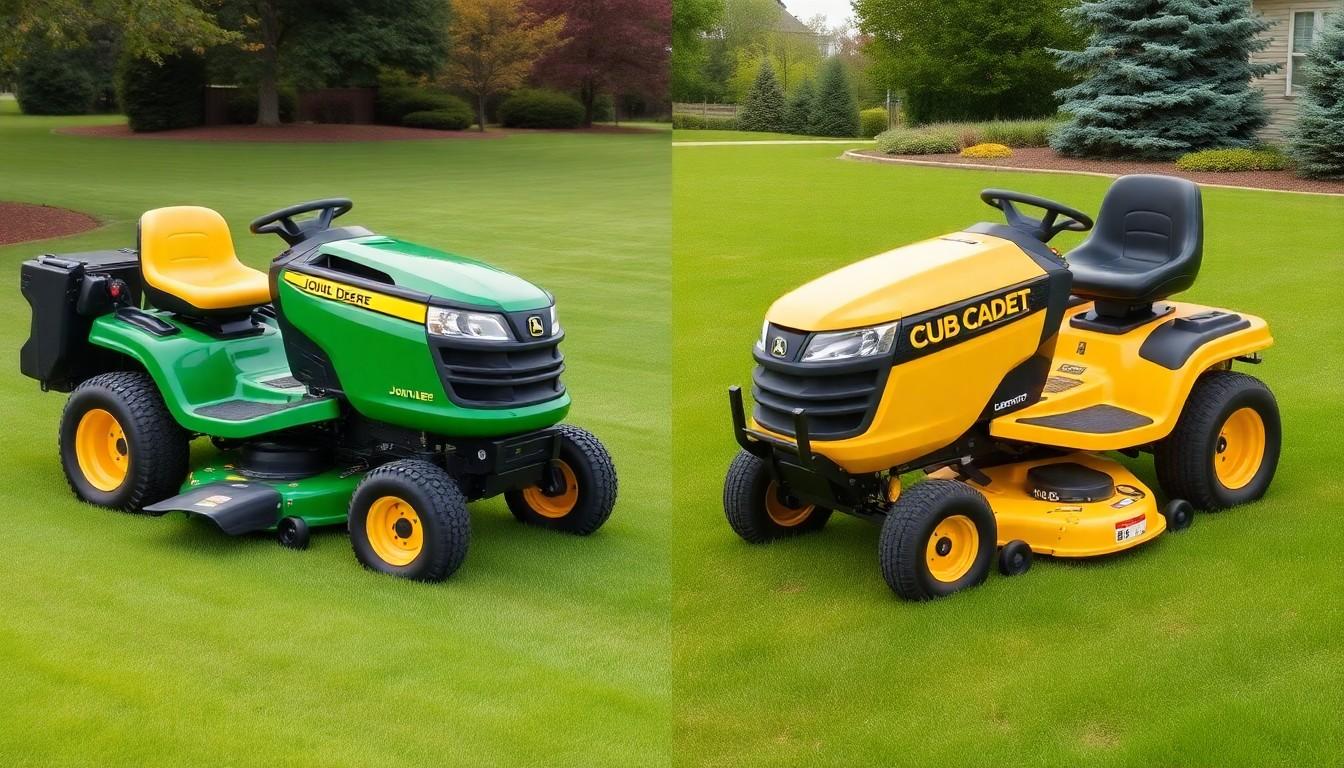
The choice between Cub Cadet and John Deere eventually depends on your exact lawn care priorities and budget considerations. Consumer Reports data from 9,570 lawn tractor owners reveals John Deere’s superior reliability, with only 22% of models breaking down by the fourth year compared to Cub Cadet’s 37%. This important reliability gap makes John Deere the clear winner for those prioritizing long-term dependability.
Performance testing demonstrates John Deere’s advantages in crucial handling aspects including braking, steering, turning, and overall stability. The John Deere D130, for example, delivers a more refined riding experience than comparable Cub Cadet models such as the XT1 LT42. These operational benefits translate to safer, more comfortable mowing sessions across various terrain types.
Cub Cadet excels in specialized functions like mulching, with models like the XT1 LT42 outperforming John Deere counterparts. Adding a mulch kit costs between $30-$60, representing a modest investment for superior mulching capabilities. Their equipment also features better control arms, higher-quality seats, and premium features like LED lighting.
Build quality comparison shows mixed results between the brands. John Deere typically uses thicker, more durable materials for critical components, as evidenced by the 12-gauge stamped deck on the ZTrack Z315E versus Cub Cadet’s 13-gauge deck on the Ultima ZT 42″. Cub Cadet compensates with larger rear tires and enhanced operator comfort features.
Price consideration favors Cub Cadet for budget-conscious buyers, offering comparable functionality at a lower initial investment. John Deere’s premium pricing reflects its enhanced reliability and performance characteristics. Our analysis indicates that even though the higher upfront cost, John Deere’s lower repair rates often result in better long-term value.
| Factor | John Deere | Cub Cadet |
|---|---|---|
| Reliability (% breaking by 4th year) | 22% | 37% |
| Deck Thickness (gauge) | 12 | 13 |
| Mulching Performance | Good | Excellent |
| Price Point | Higher | Lower |
| Handling & Stability | Excellent | Good |
Conclusion
Choosing between Cub Cadet and John Deere eventually depends on your exact needs and priorities. Cub Cadet offers powerful engines and better initial value with lower price points and excellent mulching capabilities.
John Deere stands out with superior durability proven by lower breakdown rates better handling and higher resale values. While you’ll pay more upfront for a John Deere their long-term ownership costs often balance out through fewer repairs.
We’ve found that budget-conscious homeowners with smaller properties may prefer Cub Cadet while those seeking long-term reliability for larger properties might find John Deere worth the investment. Both brands deliver quality equipment backed by established reputations in the lawn care industry.
Frequently Asked Questions
Which brand offers better engine power, Cub Cadet or John Deere?
Cub Cadet typically offers more powerful engines in comparable models, with residential equipment ranging from 18 to 25 HP. John Deere engines range from 18 to 37 HP, with a focus on consistent power delivery rather than raw horsepower. Cub Cadet’s entry-level models often feature higher HP ratings than similarly priced John Deere models.
Are John Deere lawn tractors more expensive than Cub Cadet?
Yes, John Deere lawn tractors are generally more expensive than comparable Cub Cadet models. Entry-level John Deere tractors start around $1,799, while similar Cub Cadet models begin at approximately $1,499. The price difference reflects John Deere’s premium build quality, superior handling, and better long-term reliability.
Which brand offers better warranty coverage?
Cub Cadet offers more generous warranty coverage with a 3-year limited warranty on most residential equipment, including unlimited hours for their Ultima ZT series. John Deere provides a 2-year bumper-to-bumper warranty with a 200-hour limit for similar models. Both brands require product registration to activate warranties.
Does Cub Cadet or John Deere have better build quality?
John Deere generally has superior build quality with thicker materials and more robust construction. Their mower decks typically feature 12-gauge stamped steel compared to Cub Cadet’s 13-gauge decks. This contributes to John Deere’s better durability, fewer repairs, and higher resale value, despite Cub Cadet’s solid construction.
Which brand requires less maintenance?
John Deere requires less maintenance according to reliability surveys, with only 22% of models breaking down by the fourth year compared to Cub Cadet’s 37%. John Deere’s superior handling also contributes to less wear and tear on components, resulting in lower long-term maintenance costs despite their higher initial price.
Is Cub Cadet or John Deere better for mulching?
Cub Cadet excels in mulching capabilities and generally performs better in this specific task. However, Cub Cadet typically requires separate mulch kits that add to the initial cost. Both brands offer mulching options, but reviews consistently rate Cub Cadet higher for fine cutting and mulching performance.
Which brand has better parts availability?
John Deere has a more extensive dealer network, making parts more readily available for both current and older models. Cub Cadet offers solid support through authorized dealers and retailers like Home Depot, but finding parts might require more effort, especially for older models. John Deere’s superior parts availability contributes to easier long-term maintenance.
Which brand offers better comfort for the operator?
Cub Cadet features superior seat quality and ergonomic designs, making their tractors more comfortable for extended use. Their seating systems typically offer better cushioning and support. While John Deere scores higher in handling tests, operator comfort is an area where Cub Cadet has a clear advantage across most comparable models.

